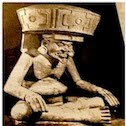In most of the old religions of the world, there are two items that stand out. One is a blue star. The other is a golden sun: more brilliant than the sun we see every day. This sun is noticable as the sun around the head. That of a god, is usually shown as a blazing halo.
In the XV through the XVI centuries there were known to be 72 different names for those gods. [We were a very small world at that time]. By the time the 1700's arrived, the color blue had been partially replaced by the color associated with witchcraft, i.e. black!
However, the color blue had a very strong hold on people around the known word. The Hagia Sofia, the Blue Mosque , was named after it. The Hawaiian goddess, Uri, was called the "Mother of all Creation." The sparkling blue robe of Guai Yin and the blue cloak of Maria were also semi-associated with it.
Yet, the missionaries did their work well in Hawaii so URI, the "Mother of all Creation " became ULI, the evil sorceress of the Black Night.
During the years that followed the Conquest of Mexico, Sahagùn began a translation of the Florentine Codex. It told the world about the "gods" of México and many of its customs. It also told the details about the Great Star which happened to be the Blue Star, but few were aware of the cross- referencing between Aztec lore and the Popol Vuh.
Since the Maya were the great hold-out and did not get "conquered until approximately the seventeenth century," no one really cared. With Linda Schele and Michael Coe, together with the photographs taken by Justin Kerr of the Maya Vases, the Maya Meetings and the Mixtec cultures became much more active.
In the meantime Professors Leon Portillo, J. Soustelle, Mary Miller, Karl Taube, and Susan Milbrath worked a bit harder on Aztec astronomy. It seemed that all cultural and astronomical problems had been covered. Then Mèxico decided to have new Metro tunnels dug for the underground rail system. Two items turned up: the Moon disk, not quite as large as the Sun disk, and later, a panel of a goddess called Tlaltecuhtl, with fragments of blue paint on her body.
- Miller, and Karl Taube had a description of this goddess that matched the moon disk goddess of the torn-apart body, Coyotlxauhquiu. The moon disk was not a painted piece so she was identired differently from Tlaltecutli. She became the star daughter of Coatlicue.
The Popol Vuh maybe, but never in the Madrid, you say? Really?
On pages 112 to 103 of the Madrid Codex several things are visible:
One: The Great Star ìs blaźing in the sky;
Two: The Rain of Resin [or the Rain of Turpentine] is falling;
Three: The Wooden Manikins are being carved [pp. 102-100] and
Fòur: A series of mummies are being prepared for burial. [pp. 99-96]
Tribes, maybe?] Here also, on page 96 is the splitting of the tree, the
Milky Way. The Twins rise into the sky as the new section of the
Via Lacta.
Five: More death panels, more people dying without proper burials.[p. 95]
Tlaltecuhtl loses her head, etc. On the following page, other sky
ladies come down with their sky baggage to comfort her. A sky lord
of the night or a storm god gets a great thunder rattle to announce
her arrival on the earth.
The Popol Vuh is well covered even though the rest of the Madrid pages may be altered even more to accommodate the church mandates. Both secular law and ecclesiastical dogmas were tampered with at that time.
Are there any bees in the heavens; no, of course not. Then think bees and what they do, or what they feel like when they sting a person. It is more logical.




